Key takeaways:
- Community meetings highlight diverse personal stories, emphasizing the real-world impacts of climate change and the importance of shared experiences.
- Effective communication strategies, such as open dialogue and visual aids, can engage residents and empower them to take part in climate action.
- Engaging diverse voices through tailored participation methods fosters inclusivity and enriches discussions around climate solutions.
- Local initiatives, like community gardens and renewable energy projects, demonstrate how grassroots actions can lead to significant environmental benefits.
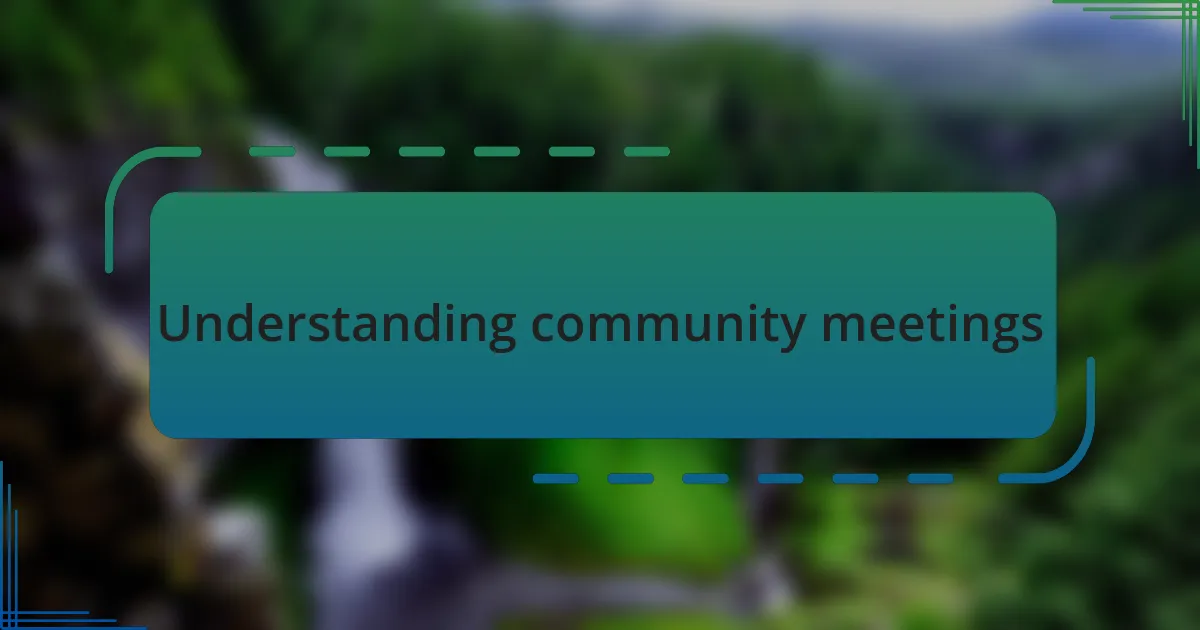
Understanding community meetings
Attending community meetings can be an enlightening experience, offering a window into the collective consciousness of local residents. I remember my first meeting vividly; the energy in the room was palpable, and I felt a mix of curiosity and nervousness as people voiced their concerns about climate impacts in our area. How often do we actually get to hear the voices of our neighbors and understand the issues they face?
In these gatherings, the diversity of perspectives is striking. For instance, I recall a woman sharing her story about how rising sea levels affected her family’s property, something I had never considered before. It made me realize how climate change isn’t just a statistic; it’s woven into the fabric of our daily lives. It’s vital to listen actively because each shared experience can enhance our understanding of the collective challenges we face.
These meetings often spark deeper reflection on our environmental responsibilities. I’ve left many sessions pondering how our individual actions ripple through the community, shaping local progress toward sustainability. Have you ever felt that urging in your gut to do more after hearing a community member’s challenge? It’s a powerful reminder that we are all in this together, and every voice matters in the fight against climate change.

Importance of climate action
Addressing climate change is not just an environmental obligation; it’s a moral imperative. During a recent community meeting, a local teacher spoke passionately about the impact of air pollution on her students’ health, highlighting how climate inaction compromises their future. Listening to her made me realize that climate action is not an abstract idea—it directly affects our children and the generations to come.
Every small step we take can have a monumental impact, but it requires collective effort. I remember a discussion about community gardens, where residents shared stories of how growing their own food not only reduces carbon footprints but also strengthens social bonds. Isn’t it fascinating how tackling climate issues can also enhance community resilience? Our actions echo through the fabric of society.
Ultimately, the importance of climate action lies in its ability to bring people together around a shared goal. After one meeting, I felt a renewed sense of hope as we brainstormed local initiatives to reduce waste. It struck me that united efforts can transform our neighborhoods, proving that each of us plays a critical role in steering the course towards a sustainable future. How many opportunities do we have to influence meaningful change? The answer lies in our willingness to engage and act.
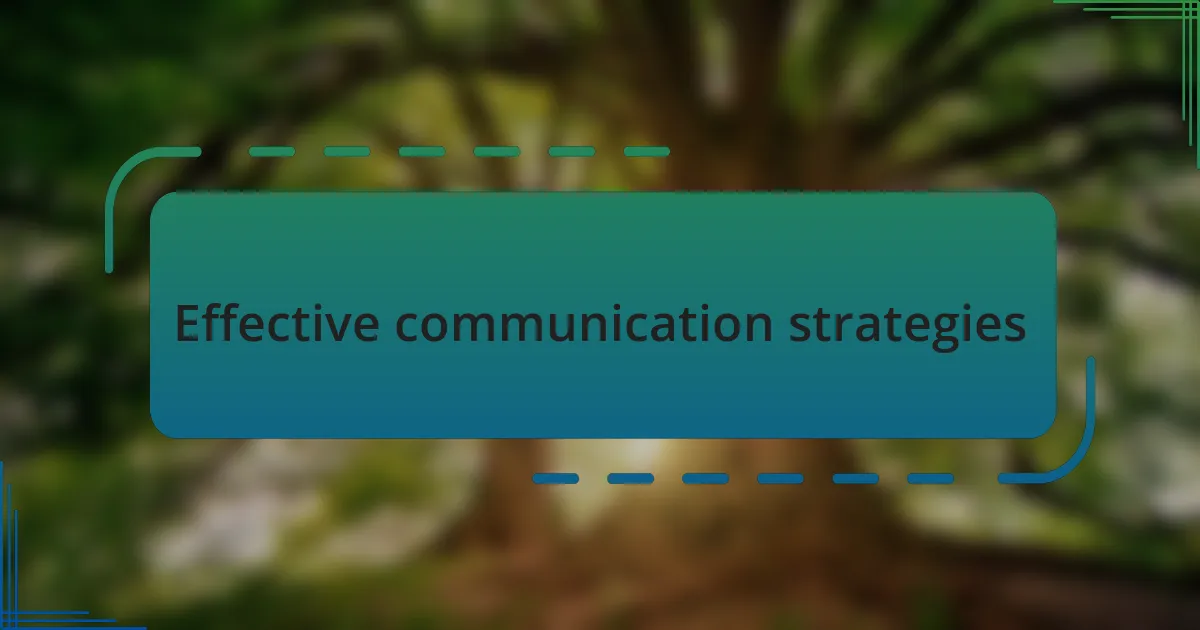
Effective communication strategies
Effective communication lies at the heart of any successful climate action initiative. During one community meeting, I witnessed how a simple, clear presentation on recycling led to an animated discussion among residents who initially thought they lacked knowledge on the topic. This moment reminded me that breaking down complex ideas into digestible pieces can empower everyone to join the conversation.
One strategy that proved invaluable was encouraging open dialogue. At a local workshop, I felt an incredible shift in energy when participants were invited to share their personal climate stories. This not only created a safe space for expression but also built genuine connections. Isn’t it amazing how sharing personal experiences can ignite passion and motivate others to take action?
Moreover, visual aids can enhance understanding and retention. When a speaker used infographics to illustrate the effects of climate change on our community, it resonated deeply with those attending. I found myself reflecting on how compelling visuals can transform statistics into relatable narratives. Have you ever noticed how a striking image or graph can elicit a stronger emotional response than just speaking about numbers? That’s the power of effective communication.
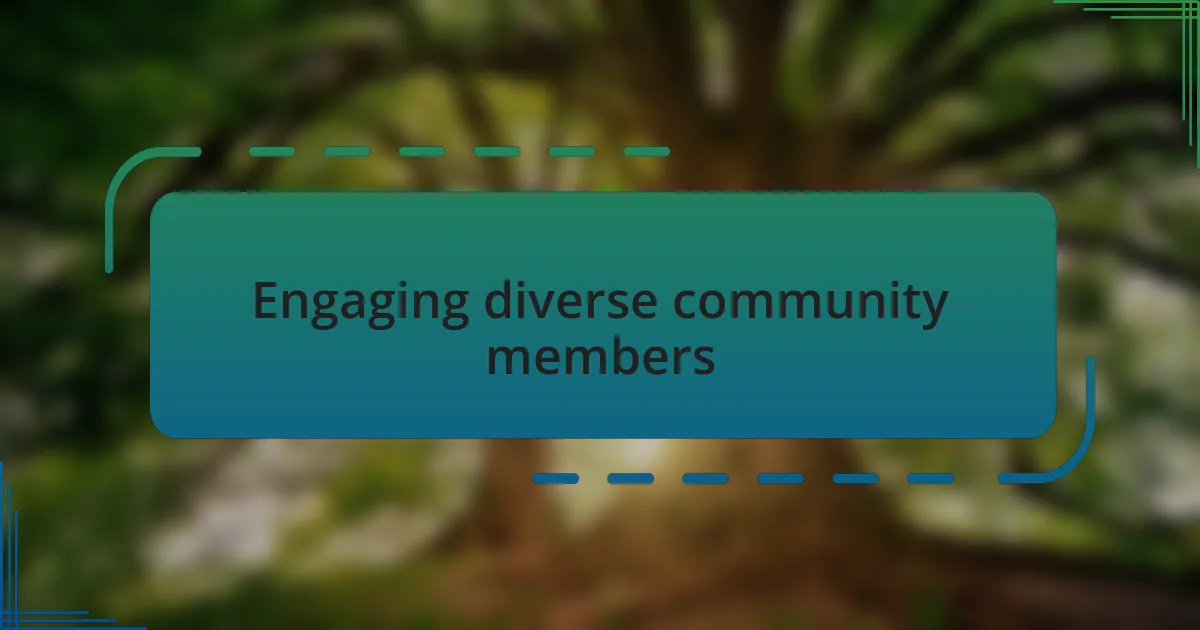
Engaging diverse community members
It’s essential to recognize the unique perspectives each community member brings to the table. One time, at a community meeting focused on urban gardening, I was amazed by how a single participant shared their family’s history of gardening from generations past. This story not only enriched our conversation but also highlighted traditions that many hadn’t considered. Have you ever experienced how a single story can shift the dynamic of a discussion and foster a sense of belonging?
To truly engage diverse voices, I learned that tailoring participation methods can make a significant difference. During another meeting, breakout groups were formed based on language preferences, ensuring that non-English speakers could fully express their thoughts. I remember how empowering it felt to see participants come alive when they could communicate in their native tongues. Why should anyone feel excluded when their voice is vital to the cause?
Lastly, creating a welcoming environment is crucial for fostering inclusivity. I recall a meeting where the organizers set up a cozy outdoor space with refreshments and seating circles. The relaxed atmosphere allowed individuals to feel comfortable sharing their ideas. Do you think a simple change in setting could lead to more engaging conversations? I certainly do; it reminds us all that climate action is a collective journey, and every voice matters in shaping our direction.
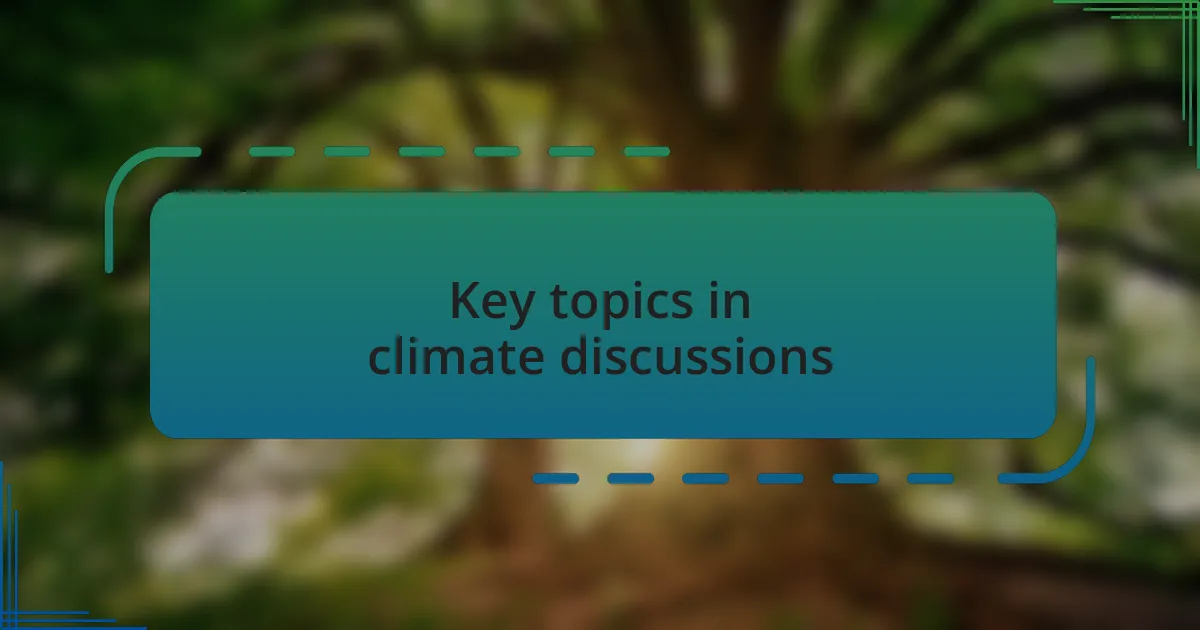
Key topics in climate discussions
Understanding the key topics in climate discussions often leads to vital insights about the challenges we face. For instance, during a recent community meeting about renewable energy, I was struck by how folks shared not only the technical aspects of solar panels but also the emotional weight of energy independence in vulnerable neighborhoods. Isn’t it powerful to realize that energy solutions are not just about technology, but about empowering communities?
Another significant topic I encountered revolves around climate justice, particularly how marginalized communities bear the brunt of environmental degradation. I’ll never forget a poignant moment when a participant spoke about flood damage in their community, linking it to systemic inequalities. It made me ponder: how can we address climate change effectively if we don’t center those most affected in our discussions?
Finally, the role of local food systems emerged as a crucial point in our conversations. One participant revealed how urban farms can combat both food deserts and carbon footprints simultaneously. This revelation ignited a vibrant discussion about sustainable practices and community resilience, prompting me to ask: what if every neighborhood prioritized growing their own food? The excitement was palpable, proving that local solutions can have global impacts.
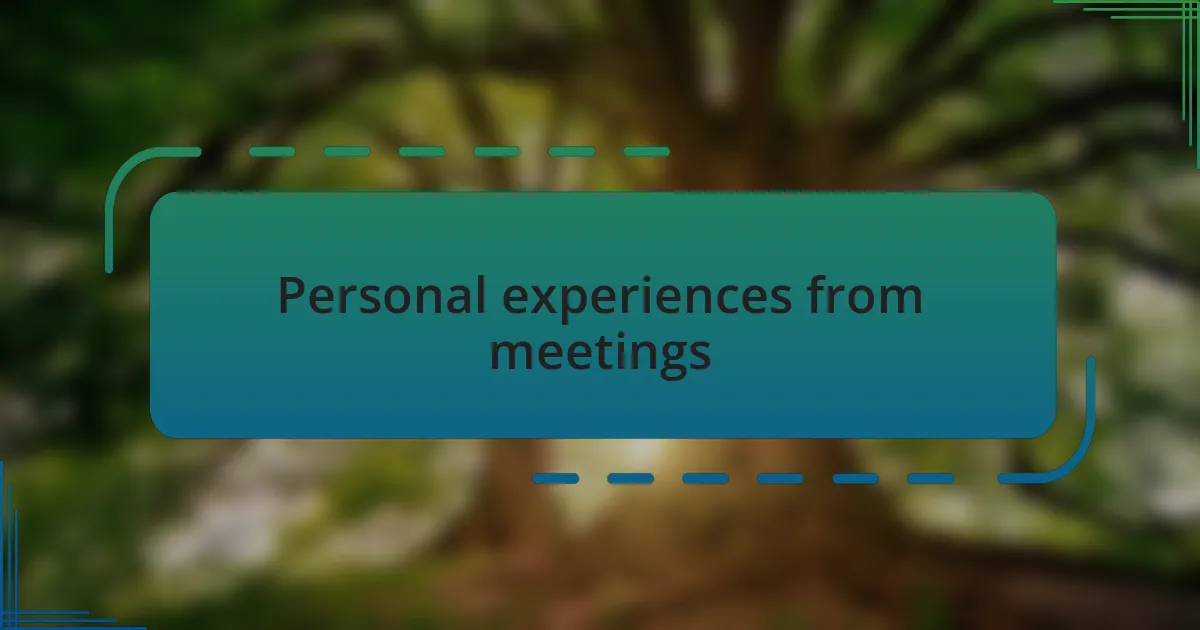
Personal experiences from meetings
During one community meeting, I remember sitting next to an elderly woman who shared her story about the heatwaves affecting her health. Her description of the physical toll it took was palpable; you could feel the worry in her voice. It made me reflect on how climate change isn’t abstract—it directly impacts real lives, and our discussions need to embrace these personal stories to truly resonate.
At another gathering, a local activist shared her experience organizing clean-up drives in polluted neighborhoods. I felt inspired as she spoke about the enthusiasm of volunteers, particularly young people eager to make a difference. It raised a question in my mind: How do we maintain that momentum beyond these initiatives? The energy in the room suggested that community action could spark broader systemic changes if nurtured correctly.
I also recall a session focused on transportation solutions. A participant passionately described his struggles commuting through areas lacking public transport options. His frustration illuminated another layer of our climate discussions: how the lack of accessibility affects everyone. Moments like this remind me how interconnected our challenges are—addressing climate action requires us to consider equity and accessibility at every level.
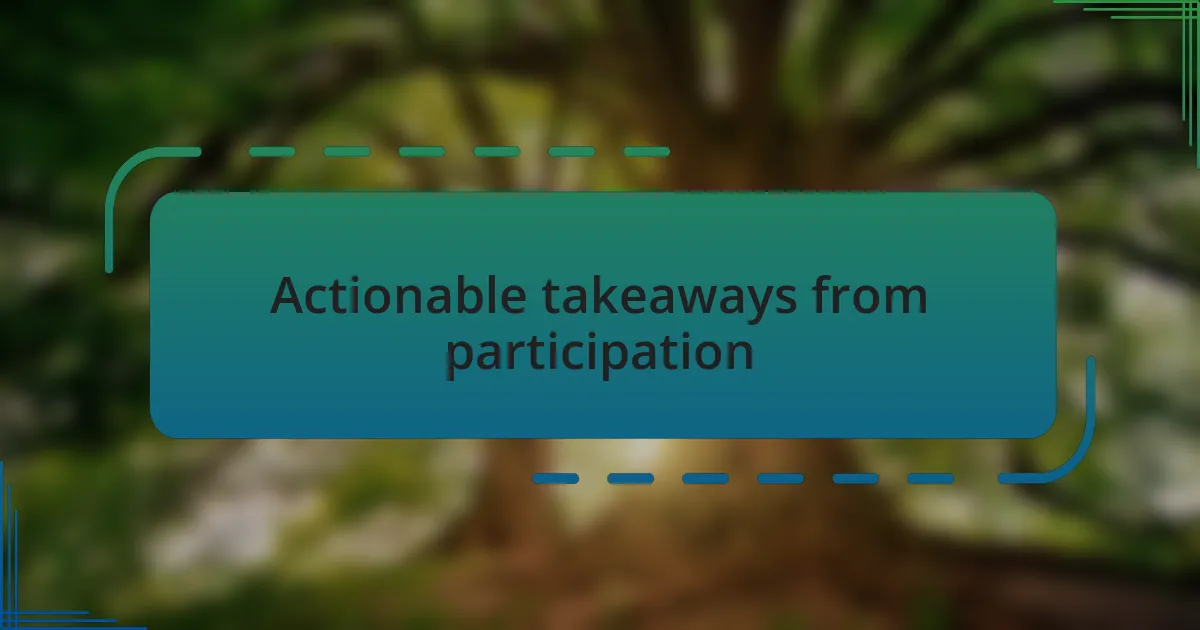
Actionable takeaways from participation
Engaging in community meetings taught me the importance of making climate action personal. I remember when a middle-aged man shared how rising sea levels had forced his family to relocate, drawing tears from many in the room. His plea highlighted a crucial takeaway: we must translate our broader climate goals into concrete, relatable actions that resonate on an individual level.
One of the most eye-opening moments for me involved a discussion around community gardens. As someone who often overlooked food systems in climate conversations, I was struck by how the attendees emphasized local food production as an act of resilience. It made me consider: What actions can I take to support local agriculture? It’s a reminder that small, local initiatives can have powerful ripple effects in our fight against climate change.
During a workshop on renewable energy, I sat across from a young engineer who passionately detailed his neighborhood’s transition to solar power. His excitement was contagious, and I found myself wondering how we could replicate that success in other areas. This experience reinforced my belief that sharing successful stories can inspire more people to engage and innovate in sustainable practices. It’s clear to me now that participation isn’t just about discussions; it’s about transforming experiences into actionable plans that can elevate our communities.